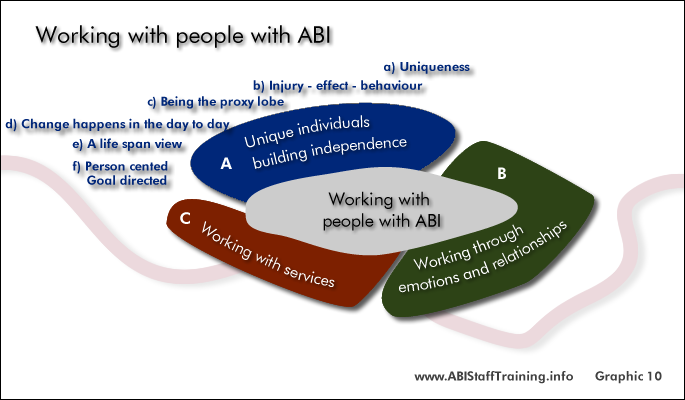- MODULE 2: Working with ABI
- Introduction
- Take the Pre-test
- A. Uniquely building independence
- a) Unique
- b) Injury-Effect-Behaviour
- c) Frontal lobe proxy
- d) Change happens
in the day to day - e) A life span view
- f) Person centred, Goal directed
- B. Through emotions and relationships
- g) Person with ABI
- h) Family members
- i) Grief and loss
- j) Support workers
- k) Managers and Team leaders
- l) Case managers
- m) Professional boundaries
- C. With services
- n) Pathways
- o) Part of a team
- p) The services network
- D. Principles and standards
- q) Principles and standards
- E. Integration
- r) Practice tools
- s) Case study
- t) Further learning
- Take the Post-test
A. Unique individuals building independence 
i) Introduction - Building independence
Quality human services are designed to promote independence. Most government funding accreditation standards and non-profit organisations espouse building independence as a value.
So why is building independence a key message for working with people with ABI?
Building independence for people with ABI is not the same as when you are providing services in a disease model, an aged care model, or a disability model of service.
In a disease model independence is in the context of the known progression of the disease.
In an aged care service independence is in the context of the ageing process.
In an intellectual disability service independence is in the context of a known intellectual disability and habilitation.
Within the ABI context independence can grow over time - even the long term.
Building an independent life will include (where possible)
- work
- leisure
- finances
- legal
Rehabilitation is the process of building independence.
Rehabilitation enables a person to become as independent as they possibly can. The goal is for the person to return to their previous abilities, activities and way of life as much as they possibly can. It means enabling the person to live with their remaining abilities and develop strategies to enable them to compensate and overcome new difficulties.
Rules of thumb
- People with an acquired brain injury can grow in their skills for independence in the short and long term (except where the ABI is caused by a degenerative disease).
- The rate of development can be slow and so not noticed. People give up too soon.
- Most people with a traumatic brain injury and many with other forms of ABI are young - they have a lot of life ahead of them and plenty of time to develop.
- People with an ABI often have some very good skills in some areas but very poor skills in other areas.
- People with ABI may need support to manage independent skills for life when they can't maintain a skill on their own.
Strategies
There are many strategies for promoting independence.
Building blocks include:
Identifying and prioritising issues
Setting goals
Monitoring progress
One worker said:
I guess another message is to remember to work alongside the client rather than do things for people.
This is a very big message: We are about enabling independence not about doing things for people. So if you are doing tasks like washing up, while it might seem easier for you to just get in and do it all, encourage participation so someone washes and the other person wipes. It is about working together and cementing those skills so that when a person doesn't have support they are able to function and do those things for themselves.
A person with ABI said:
I think the biggest thing that is noticeably still here with me since my accident is my independence and just doing things myself and knowing that they have to be done and knowing that I have to do them, and not relying on anyone else because I have to get to the point where I am going to be able to do things, everything by myself. I am not always going to be able to depend on someone else to be there to do it for me because that is the easy way out or whatever.
ii) Key messages
The starting point:
A. Unique individuals building independence

iii)Questions
Answer the following question:
Most of the clients your service works with are clients with an intellectual disability.
You have three new clients with an acquired brain injury. You have an existing staff member to support these clients.
You are talking with the staff member about the importance of building independence in working with people with acquired brain injury.
What are some of the points you make?
1. Intellectual disability is present from birth ABI is not.
2. People with an ABI have had a life before the ABI.
3. Working with people with ABI is rehabilitation - the goal is for the person to return to their previous abilities, activities and way of life as much as they possibly can. It means enabling the person to live with their remaining abilities and develop strategies to enable them to compensate and overcome new difficulties.
4. Most people with an ABI retain their pre-injury intellectual abilities, the injury having merely impaired the expression of these abilities.
5. With treatment and support, most people with an ABI can expect their symptoms to improve and to recover some of their former capabilities through rehabilitation. By contrast, people with an ID are more likely to be involved in habilitation programs (being able to make the most of their current capabilities).

